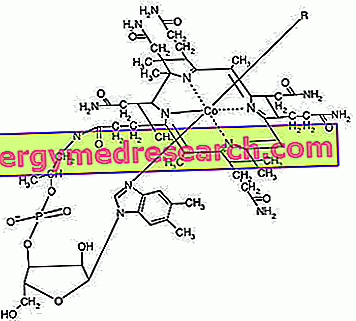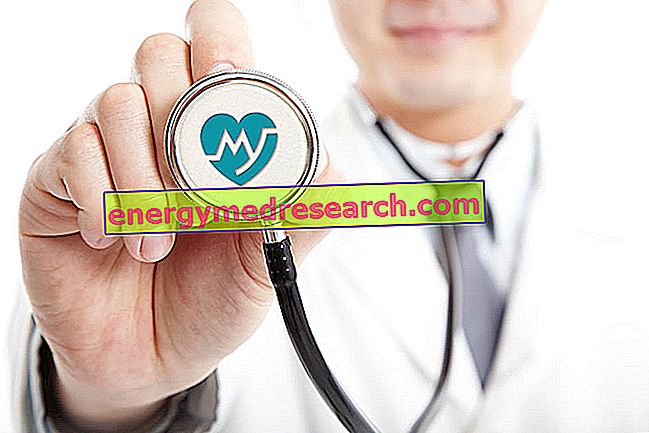By Doctor. Gianluca Rizzo - Nutritionist
One of the most discussed and now most commonly accepted aspects of vegetarian nutrition is the need for vitamin B12 supplementation and its potential risks in deficiency states.
Why is it necessary to integrate the B12?

Another often proposed theory hypothesizes that, since there is indeed a conspicuous production of B12 within our intestine by the intestinal microbiota, our nutritional requirement is almost nil. Unfortunately this is also erroneous and the demonstration is inherent in the mechanism of absorption of the same vitamin. The B12 before being absorbed is bound by the salivary polypeptide R thanks to the acid pH of the stomach, afterwards it transfers the vitamin to Castle's intrinsic factor which mediates its intestinal absorption at the level of the small intestine. This implies that the cobalamin produced in the large intestine has no hope of being absorbed since there is no local availability of the relevant transport factors. Many animals have the strange behavior of eating stool, which would explain a strategy of recovery of minerals and vitamins synthesized in the terminal tracts of the intestine.
Another theory that must be dispelled is the presence of cyanobacteria associated with marine algae which, ingested by human beings, can be a food source of B12. Also in this case the rule of the tank is valid because only fish can absorb a sufficient amount of active vitamin through marine food (corrinoids), while algae-based foods do not have a high enough level to be a source of B12 for being human or may contain non-active analogues. The presence of plant analogues of cobalamin seems to have a potentially harmful effect because it causes the deactivation of active B12, decreasing its bioavailability, as happens with the analogues of many algae (PE spirulina).
All this absolutely does not want to discourage the vegetarian choice but, on the contrary, stimulate the attention towards the need for a correct integration. Cyanocobalamin supplements derived from bacterial biotechnologies are now available on the market that allow a correct integration program and an effective prevention of possible deficiencies.
Daily requirement of Vitamin B12

The daily requirement is 2-2.5 µg per day but for supplementation we generally recommend a dose of 10 µg from supplements or 2 µg total per day from fortified foods. Too high doses can significantly reduce the bioavailability due to the absence of intrinsic factor. In any case, the vitamin is highly thermolabile so even omnivores should not underestimate it in cases of potential shortage. Integration is fundamental at various stages of life and should never be underestimated. In pediatric age there is a strong need for this vitamin in order to allow a correct cell expansion during the growth phase. We must keep in mind that even in gestation and lactation, a correct balance of B12 in the mother allows the fetus or newborn to have a regular intake, not having in these phases another vitamin source outside the maternal one.
In adulthood, B12 participates in the removal of homocysteine, a potentially harmful molecule for the cardio-vascular system and the brain district.
Even in old age, but not only for vegetarians, cobalamin becomes a very important factor for a correct homeostasis since in this phase of life it is easy to manifest latent deficiencies or dependent on common senile malnutrition, and pathologies closely associated also to the same homocysteine, as recently discovered for Parkinson's. It seems that this molecule can disrupt the cerebral microvenous fitness while the hypomethylation of DNA due to B12 deficiency may favor alterations in the neurotransmitter inter-synaptic communication systems. In old age the subclinical deficiency can act subtly due to insufficient intake, alterations in absorption, achlorhydria or alterations in the production of intrinsic factor.
Obviously the more the vegetarian diet will be restrictive and the more attention must be paid to this possible deficiency; this is because vegan ovo-latto, having access to foods rich in B12 on average, may not need integration, while vegans, having no animal sources, will necessarily have to use supplements. This means that, while international publications have highlighted the advantages of a vegetarian diet for cardiovascular fitness, the shadow of hyperhomocysteinemia due to B12 deficiency could nullify them, increasing the risk of coronary heart disease.
Vitamin B12 deficiency: Diagnosis and blood test
Another aspect that can be useful to investigate is represented by the diagnostic systems available for detecting the possible deficiencies of cobalamin . The most commonly used method is the total cobalamin dosage but, for some time now, the scientific community has shown that this may be an index that is not very sensitive to the real condition of the disease. Added to this is the fact that the need for B12 in humans is very low and our body is able to effectively save the important vitamin so as not to require large quantities with the diet. This implies at the same time that the state of deficiency is subtle and with a slow action that can manifest itself with serious consequences in an unexpected and irreversible way even after 5 - 10 years of dietary deficiency. In fact, the lack of vitamin B12 is the first cause of megaloblastic anemia also known as pernicious due to its characteristics, as well as other important effects on central and peripheral neuronal demyelination that can lead to potential neuropsychiatric disorders.
Much more sensitive diagnostic targets are represented by the dosage of olotranscobalamina II, methylmalonic acid and homocysteine.
Holotranscobalamina II represents the active cobalamin fraction, linked to the transcobalamin II transport factor which aims to distribute the vitamin to the various districts. It has a short half-life (6 'versus 6 days of total B12), represents no more than 30% of all cobalamin and has been experimentally demonstrated that cellular membrane receptors for the incorporation of the complex are ubiquitous. Most of the absorbed cobalamin is bound to the aptocorrin, a transport protein that does not seem to have the function of distributing the vitamin to various districts but of mediating a scavenger function through theoretical retrograde transport to the liver, perhaps of harmful analogues, the hepatocytes being the only cells that have the relative membrane receptor for the internalization of the B12-aptocorrine complex. The detection of holotranscobalamina II (holoTCII) correlates much more effectively with vitamin deficiency than total B12.


From these data it is easy to see that the diagnosis must always be made by an informed medical staff who is able to interpret the picture described by the results, together with the anamnestic information such as eating habits, renal function with creatinine, correct intestinal function and overall cardiovascular risk.
The B12 deficiency stages have been divided into 4 degrees. The first two are characterized by mild plasma deficiency and decreased cellular reserves, but with total B12 levels in the physiological range, while it can be found in holoTCII levels. In the third stage a functional deficiency can already be detected with an increase in MMA and HCY. In the fourth stage a lowering of cobalamin levels below the physiological range is already noticeable but with the possible establishment of irreversible conditions affecting the nervous tissue and red blood cells, with lowering of hemoglobin levels and alteration of the erythrocyte volume. It is therefore understandable the importance of a diagnostic system that allows to detect the condition of deficiency before a situation that is difficult to recover is created. It can thus be easily deduced that low levels of holoTCII alone do not allow to distinguish between the 4 stages, while normal levels of MMA and HCY do not exclude the possibility of I or II stage; this clearly indicates that no single index can have the prognostic value of the complete picture of the relative levels .
In studies on the correlation between diet and B12 deposits, a gradual deficiency has been noted that increases from omnivores towards vegan ovo latto to vegans and raw foodists . For example, in one study, B12 levels of 1%, 26%, and 52% were found below the physiological values in vegan and vegan omnivores, ovo lattoos respectively, with holoTCII levels of 11%, 73% and 90 % below physiological values, and MMA levels increased by 5%, 61% and 86%. The correlation between the total B12 and holoTCII is greater at higher values while at lower values it loses significance; this implies that in the vegetarian individual a functional deficiency may already be present at medium-low levels of total cobalamin and for this reason some researchers propose to restrict the physiological range for vegetarians above 360 pmol / L of B12. Based on similar correlation curves, holoTCII levels above 50 pmol / L may be a good index of vitamin reserves while below this level in vegetarians, although in the physiological range, comparison with others would still be recommended indices.
The control of the early indices of cobalamin deficiency is fundamental for all asymptomatic subjects and with B12 levels in the norm but belonging to risk categories . These categories do not only concern vegan individuals but also elderly and smokers (as mentioned), as well as obese (altered vitamin absorption), women in estroprogestinica therapy (hormonal alteration), sports (increased metabolism), individuals with gastric resection (achlorhydria and malabsorption), celiacs, individuals with IBD and diseases affecting the gastro-intestinal tract, alcoholics and drug addicts or simply on continuous drug therapy (malabsorption).
Physiological ranges - Blood analysis
- B12:> 135 pmol / L
- holoTCII:> 35 pmol/L
- MMA: <271nmol / L
- HCY: <13 umo / L
Essential bibliography
- Arch Neurol. 1998 Nov; 55 (11): 1449-55. Folate, vitamin B12, and serum total homocysteine levels in confirmed Alzheimer disease. Clarke R, Smith AD, Jobst KA, Refsum H, Sutton L, Ueland PM.
- Clin Chim Acta. 2002 Dec; 326 (1-2): 47-59. Vegetarian lifestyle and monitoring of vitamin B-12 status. Herrmann W, Geisel J.
- Am J Clin Nutr. 2003 Jul; 78 (1): 131-6. Vitamin B-12 status, particularly holotranscobalamin II and methylmalonic acid concentrations, and hyperhomocysteinemia in vegetarians. Herrmann W, Schorr H, Obeid R, Geisel J.
- Clin Chem. 2003 Dec; 49 (12): 2076-8. Holotranscobalamin as an indicator of dietary vitamin B12 deficiency. Lloyd-Wright Z, Hvas AM, Møller J, Sanders TA, Nexø E.
- Journal of clinical ligand assay. - ISSN 1081-1672. - 13: 3 (2008), pp. 243-249. Preclinical deficiency status of vitamin B12 in asymptomatic subjects: importance of olotranscobalamin dosage (active vitamin B12). Novembrino C, De Giuseppe R, Uva V, Bonara P, Moscato G, Galli C, Maiavacca R, Bamonti F.
- Clinical Biochemistry 2009; 33 (5) 306. Determination of serum olotranscobalamina: analytical evaluation and role in asymptomatic smokers. De Giuseppe R, Uva V, Novembrino C, Accinni R, Della Noce C, Gregori D, Lonati S, Maiavacca R, Schiraldi G, Bonara P, Bamonti F.
- Meat Sci. 2013 Mar; 93 (3): 586-92. doi: 10.1016 / j.meatsci.2012.09.018. Epub 2012 Oct 31. Meat nutritional composition and nutritive role in the human diet. Pereira PM, Vicente AF.



